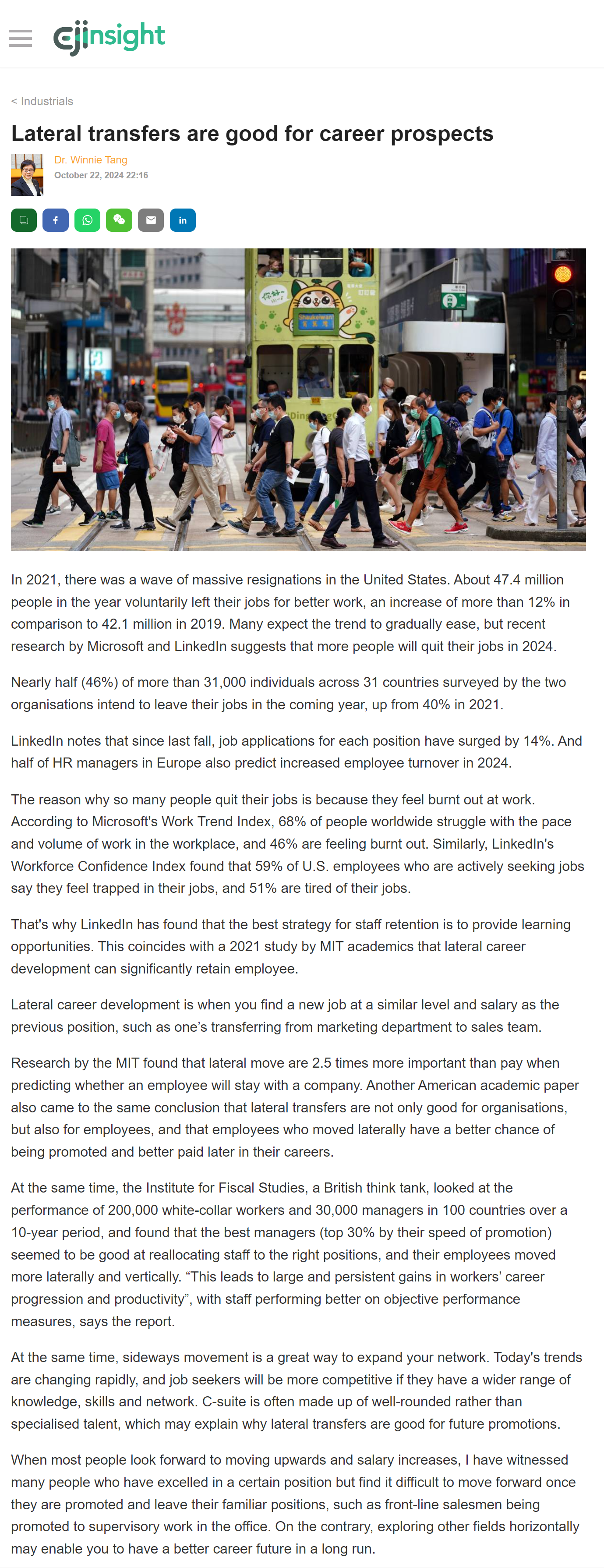網上版請按此

Lateral transfers are good for career prospects
In 2021, there was a wave of massive resignations in the United States. About 47.4 million people in the year voluntarily left their jobs for better work, an increase of more than 12% in comparison to 42.1 million in 2019. Many expect the trend to gradually ease, but recent research by Microsoft and LinkedIn suggests that more people will quit their jobs in 2024.
Nearly half (46%) of more than 31,000 individuals across 31 countries surveyed by the two organisations intend to leave their jobs in the coming year, up from 40% in 2021.
LinkedIn notes that since last fall, job applications for each position have surged by 14%. And half of HR managers in Europe also predict increased employee turnover in 2024.
The reason why so many people quit their jobs is because they feel burnt out at work. According to Microsoft's Work Trend Index, 68% of people worldwide struggle with the pace and volume of work in the workplace, and 46% are feeling burnt out. Similarly, LinkedIn's Workforce Confidence Index found that 59% of U.S. employees who are actively seeking jobs say they feel trapped in their jobs, and 51% are tired of their jobs.
That's why LinkedIn has found that the best strategy for staff retention is to provide learning opportunities. This coincides with a 2021 study by MIT academics that lateral career development can significantly retain employee.
Lateral career development is when you find a new job at a similar level and salary as the previous position, such as one’s transferring from marketing department to sales team.
Research by the MIT found that lateral move are 2.5 times more important than pay when predicting whether an employee will stay with a company. Another American academic paper also came to the same conclusion that lateral transfers are not only good for organisations, but also for employees, and that employees who moved laterally have a better chance of being promoted and better paid later in their careers.
At the same time, the Institute for Fiscal Studies, a British think tank, looked at the performance of 200,000 white-collar workers and 30,000 managers in 100 countries over a 10-year period, and found that the best managers (top 30% by their speed of promotion) seemed to be good at reallocating staff to the right positions, and their employees moved more laterally and vertically. “This leads to large and persistent gains in workers’ career progression and productivity”, with staff performing better on objective performance measures, says the report.
At the same time, sideways movement is a great way to expand your network. Today's trends are changing rapidly, and job seekers will be more competitive if they have a wider range of knowledge, skills and network. C-suite is often made up of well-rounded rather than specialised talent, which may explain why lateral transfers are good for future promotions.
When most people look forward to moving upwards and salary increases, I have witnessed many people who have excelled in a certain position but find it difficult to move forward once they are promoted and leave their familiar positions, such as front-line salesmen being promoted to supervisory work in the office. On the contrary, exploring other fields horizontally may enable you to have a better career future in a long run.
Dr. Winnie Tang
Adjunct Professor, School of Computing and Data Science; Department of Geography, Faculty of Social Sciences, The University of Hong Kong